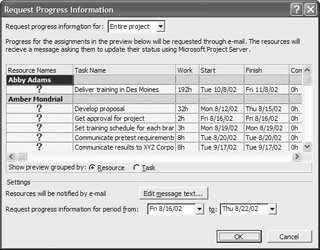Monitoring Project Progress
|
|
You monitor a project by systematically and intentionally collecting data about the status of each project task. Data can be collected in several ways:
-
During project team meetings
-
In one-on-one discussions with team members
-
Electronically by using e-mail
-
From team members’ written reports
-
As a result of correspondence or meetings with project vendors and suppliers
-
From support departments, such as purchasing and receiving
Server It’s easier to monitor progress when status reports are standardized. Project 2002 has two tools for collecting project status reports:
On Project Server If you’re running Project 2002 Server, you can exchange messages using an intranet- or Internet-based web.
| Note | Microsoft Project Server must be purchased separately; it is not included with either Project Standard or Professional. See Chapter 20 for more information. |
E-mail Collaboration Alternately, assuming all your team members have access to e-mail, you can use Project’s e-mail collaboration features (shown in action in Figure 3.2) to automatically request project updates. Team members’ responses are automatically entered in your project plan.

Figure 3.2: Use the Request Project Information dialog box to request status reports from team members.
The e-mail collaboration features require that all team members be using Microsoft Outlook or another MAPI-compatible e-mail client. If team members don’t have access to MAPI-compliant e-mail, the company’s intranet, or the World Wide Web, you can collect data manually. Manual data collection may, in fact, be the best choice for a small project with a limited number of team members. Keep in mind that you need to enter the data in your Project file, so a standardized format is still important. Decide which data you want to collect and how frequently you want to collect it. Don’t collect data more frequently than you can enter and analyze it.
If you’re collecting your data manually, you’ll need to choose from one of many possible collection methods: verbal or written reports at weekly meetings, telephone interviews, or faxable forms are all useful methods. When you provide a format for team members to use, you increase the probability that you’ll receive useful data that can be easily entered in Project. Design your forms so they are easy for your team members to complete.
| Note | Even if you use Project Server or workgroup e-mail tools, you’ll still need to manually update tasks that aren’t assigned to human resources. |
|
|
EAN: 2147483647
Pages: 241